This itinerary features a Tibet tour. Travel to China Tibet has been a dream for many travelers. The 14-day classic china tour includes the must-see cities in China and the glamorous Chengdu and Tibet. You can walk on the magnificent Great Wall as well as explore the bustling Hutong in Beijing. You can ride a bicycle on the ancient City Wall in Xi’an and appreciate the World Heritage, the Terracotta Warriors. You can walk into the Giant Panda Breeding Base and meet hundreds of the adorable giant pandas in Chengdu. And you can experience the daily life of Tibetans and the unique religious culture from the Tibetan monastery in Lhasa. Of course, the Magical City Shanghai will not disappoint you. Walking on the Bund, you can immerse yourself in the collision of history and modernity. All the cities in China have become accessible easier than before, including Lhasa in Tibet. Now is the perfect time to have an unmissable journey to China including a great Tibet tour.

Welcome to China! Upon your arrival, our guide will meet you at the arrival hall with a big smile. Then you will be transferred to the hotel. The tour guide will help you to check in at the hotel, and the rest of the day is free for you to look around or take a break.
Beijing is a charming city with both a classical and a fashionable atmosphere. You can feel its infinite modern elements and authentic Beijing flavor through hutongs, old teahouses, trendy bar streets, or bustling commercial districts. The must-see sights in Beijing are Tian’anmen Square, the Forbidden City, and the Great Wall, but there are many more to choose from depending on your interests. Whether you’re traveling with your family, your friends or your own, you’ll find the perfect place for you in Beijing.
This morning you will visit the Temple of Heaven. It is the largest ancient heaven-worshiping building complex in the world. It is an altar for the emperors in the Ming and Qing dynasties to offer sacrifices to the heavens, pray for rain and a good harvest. There is an interesting place in the Temple of Heaven, the Echo Wall. If one person stands under the west wall and speaks softly, while another person stands under the east wall can hear the voice. And the echo of the voice is long-lasting. You can have a try with your children, lover or friends. You could also have a walk in the surrounding park. There are many locals doing morning exercise in the park. If you have any interest, you could talk with the locals about what they are practicing. And you may have a chance to learn Tai Chi from some Tai Chi enthusiasts.
Then you will visit Tian’anmen Square. Tian’anmen Square, the largest city centre square in the world, is located on the south of Chang’an Street, the axis of Beijing. You will see the Monument to the People’s Heroes in the center of the square. And on the west side, it is the Great Hall of the People. The National Museum is on the east side. The flag-raising ceremony takes place every morning. Watching the ceremony is a special experience for those new to Beijing. Tian’anmen Square is the symbol of New China as well as ancient China in the Ming and Qing dynasties. It is now an open square for everyone, but was forbidden to the ordinary people in the Ming and Qing dynasties. As it was a royal square to issue decrees and hold big events.
After passing through the Tian’anmen Square, you will enter the Forbidden City (closed each Monday). The Forbidden City, also known as the Palace Museum, is the best-preserved and largest group of ancient wooden buildings in China and the world. The inner court of the Forbidden City is centered on the three palaces-the Palace of Heavenly Purity, the Jiaotai Palace, and the Kunning Palace. And there are six palaces on the east and six palaces on the west. These are living quarters of emperors, empresses, and concubines. The Forbidden City holds a large number of precious cultural relics. According to statistics, there are millions of cultural relics in the Forbidden City, accounting for one-sixth of the total number of cultural relics in China. That’s why it was also named the Palace Museum.
After lunch, you will go to the Summer Palace. The Summer Palace was the former palace and garden of the Qing emperors to spend their summertime. It has an area of 2.9 square kilometers. About three-quarters of the entire garden is occupied by Kunming Lake and there are more than 100 buildings of various types around the lake. Tower of Buddhist Incense, Stone Boat, Long Corridor, and Suzhou Street are well-known sites and must-see places to visit the Summer Palace. When visiting the Summer Palace, except for a visit to the splendid architecture of the palace, you can also take a boat ride on Kunming Lake, which is a relaxing and enjoyable way to appreciate the scenery. The rest of the day is free on your own.
Free Time Idea: If you still are energetic, you can visit Wangfujing Street by yourself. There you can buy some local souvenirs, like chopsticks. You can try to use it with your family after return back to your sweet home.
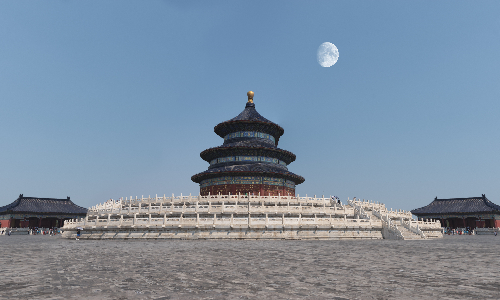
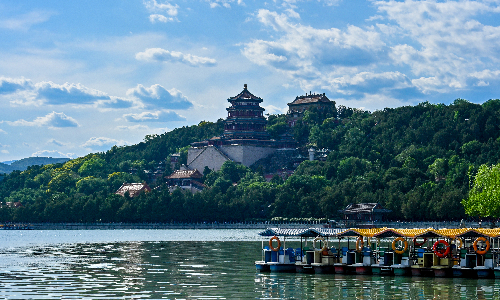
After that, we will drive for about 1 hour (50KM) to visit the Ding Tomb of the Ming Tombs. It is to the northwest of Beijing City. There are 13 tombs in the Ming Tombs, and each one is self-contained. They are tombs of the emperors and their families of the Ming Dynasty. Each tomb was built in front of a mountain and with similar specifications. Ding Tomb is located at the bottom of the Dayu Mountain and is the mausoleum of the thirteenth emperor of the Ming Dynasty and his two empresses. It is the only one of the thirteen tombs that have been excavated. Visitors can visit the underground palace after going down 27 meters from the ground.
After a simple lunch, we will drive for about 1 hour (40KM) to visit the Mutianyu Great Wall which is to the northeast of the Ming Tombs. It has a long history and splendid culture and is well-known in China and even in the world. Although there are several parts of Great Wall that you can visit in Beijing, Mutianyu Great Wall owns the most stunning scenery and there are fewer tourists, especially in the afternoon. That’s why we take you to see the Great Wall here. In addition to hiking up the Great Wall, you also have the opportunity of taking a cable chair up and then a toboggan down. The experience of going down the Great Wall by toboggan will round off your Great Wall excursion. (Safety Tips: Tourists over 60 years old are not recommended to take the toboggan)
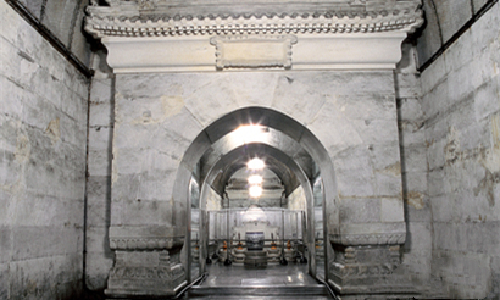
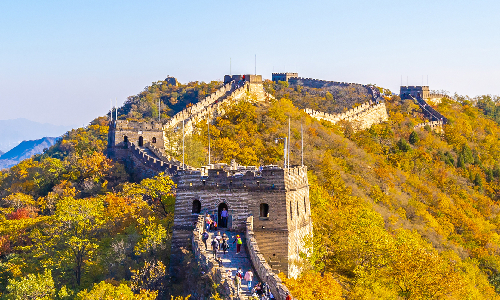
 Xi’an
Xi’an This morning, we will visit Old Beijing Hutong. Hutong is a must-visit attraction when you come to Beijing. Because only after you have walked through it can you truly feel it is extraordinary. The most unique and interesting way to visit Hutong is taking a rickshaw. It will take you to appreciate the old quadrangle courtyards and you can enter some small shops or chat with the residents. We will also take you to visit a local family, and you may get something unexpected from the host.
Then you will visit Lama Temple. It is the largest Tibetan Buddhist Gelugpa royal monastery in Beijing. Historically, it was the residence of Emperor Yongzheng in the Qing Dynasty (1636-1912) when he was a crown prince. And it also was the birthplace of Emperor Qianlong (son of Emperor Yongzheng). That is why the same yellow tiles are used here as in the Forbidden City. On the first day of Chinese New Year, a lot of people come here to compete to burn the first incense. It is believed that the first person to burn incense in the Lama Temple in the New Year will be regarded as the most pious person. In this way, his wish is more likely to be realized. If you want, you can also burn incense here and tell the Buddha your wish. Please note that photography is not allowed in all halls of the Lama Temple.
After lunch, we will drive to the airport, and you will take the estimated flight MU2112 15:20/17:30 to Xi’an. After arrival in Xi’an, our guide will pick you up at the airport, and then you will be transferred to the hotel and check in.
Free Time Suggestion: If you want to stroll in the city by yourself, the Muslim’s Quarter is the best place. Here is a concentration of Xi’an snacks. When you come here, you can taste almost all the Xi’an local snacks. There is one thing you must have a try, Pita Bread Soaked in Lamb Soup. All the locals in Xi’an are lovers of it. After you make an order of the Pita Bread Soaked in Lamb Soup, the waiter will give you a baked bun and a big bowl. You need to tear the baked bun into small pieces first and put them in the bowl. Then the waiter will take the bowl away, and put the mutton soup in it. Put some chili oil and vinegar in the soup if you like. You can recognize who are locals around you through the way that people tearing the bun. Local people always tear the bun into very tiny pieces slowly. They enjoy the leisure time very much.
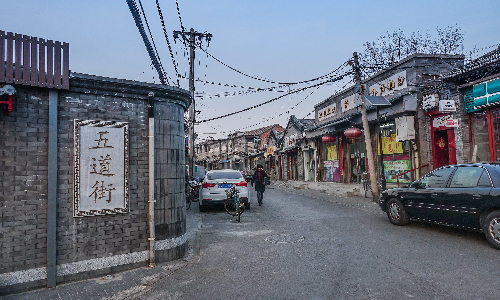
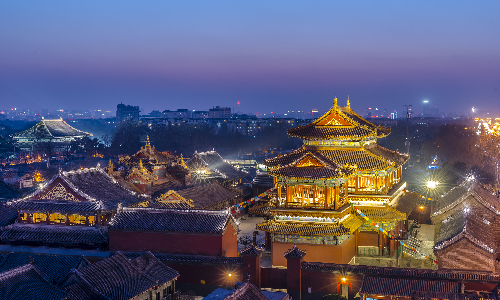
After breakfast, we will drive for about 1 hour (50KM) to visit the Terracotta Warriors and Horses Museum. It is to the northeast of the Xi’an city. It is a giant pit with burial objects in the mausoleum of the First Emperor, Qin Shi Huang. More than 7,000 terracotta soldiers have been unearthed and each with a different face and posture. Standing in front of the massive terracotta army, you will feel the ambition of Emperor Qin Shi Huang who overthrew the other six kingdoms and unified ancient China 2,000 years ago.
Then we will drive for about 50 minute (45KM) to visit Big Wild Goose Pagoda. It is located in the Ci’en Temple, and was built to store the relics, statues and sutras brought back from Tianzhu (ancient India) by Master Xuanzang in the Tang Dynasty. In 629, Master Xuanzang set out from Chang'an (ancient Xi’an) on his own along the "Silk Road". After three years of trekking, he finally reached the Buddhist holy land,Tianzhu (ancient India). Then he spent five years studying in Tianzhu. In 645, Master Xuanzang returned to Chang'an with a large number of sutras, Buddha statues, and relics. In 652, the Big Wild Goose Pagoda was built.
After that, we will see the 600 years old City Wall. It is the symbolic landscape of Xi’an. The existing wall was built in the early Ming Dynasty and is the most complete ancient city wall in China. Aside from walking, cycling on the city wall is a great way to see the city. You will enjoy the amazing city view under sunset during your cycling. The whole journey takes about 60 minutes. If lucky, we may see some folkloric performances.
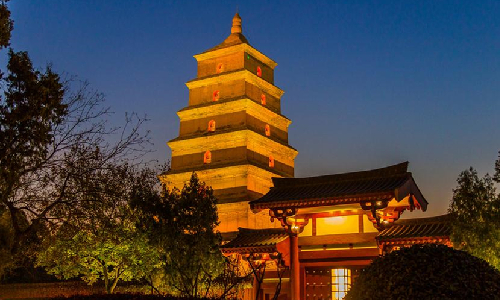
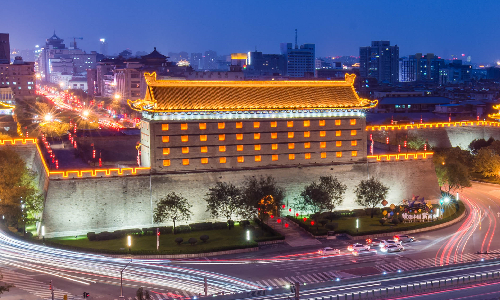
 Lhasa
Lhasa This morning you will take the estimated flight MU2335 11:40/15:20 to Lhasa. Upon your arrival at the airport, your local guide will meet you at the arrival hall and take you to your hotel. Along the way, you will have a chance to see the Yarlong Tsangpo River, the longest river in Tibet. After checking in, we recommend that you rest at the hotel today. A good rest and plenty of water will help you relieve altitude sickness.
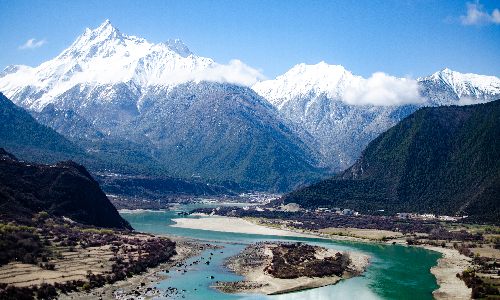
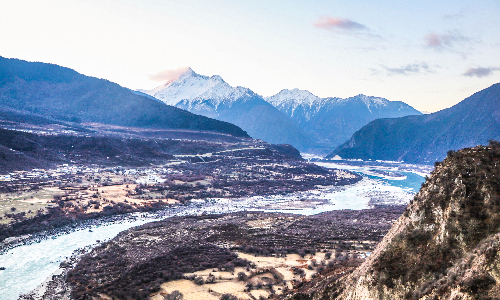
In the morning, your guide will meet you at the hotel. You will first have a visit to the Potala Palace. The Potala Palace is one of the symbolic buildings of Tibet and one of the most classical buildings representing Tibetan culture. Known as the “Pearl in the Roof of the World”, the Potala Palace is the highest palace in the world. The walls of the Potala Palace mainly include four different colors: red, yellow, white and black. According to a staff of the Potala Palace, red represents authority; yellow represents prosperity; white represents peace; black means to ward off evil spirits.
And then we will visit the Jokhang Temple. It is one of the most famous temples in Lhasa and is located in the city center. Jokhang Temple was built by Songtsen Gampo in the Tubo Kingdom(618AD-842AD) to commemorate the marriage between him and Princess Shaku Tsun. Jokhang Temple is one of the most splendid surviving buildings of the Tubo period in Tibet. After the completion of the temple, it was repeatedly modified and expanded in the Yuan, Ming, and Qing dynasties.
After visiting the temple, you will walk along Barkhor Street. As one of the famous ancient streets in China, Barkhor Street is located in the center of the ancient city. It is the best-preserved ancient street in Lhasa. Here you can buy some Tibet authentic souvenirs, including Tibetan ethnic minority clothes, bracelets, and necklaces, as well as famous herbs. There are Chinese best ganoderma, saffron and cordyceps in Tibet.
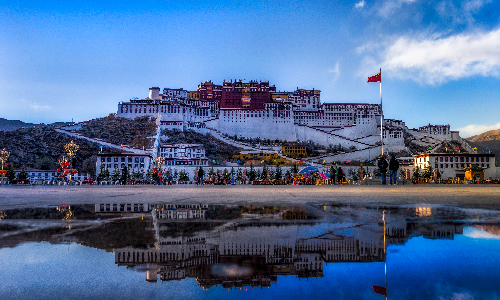
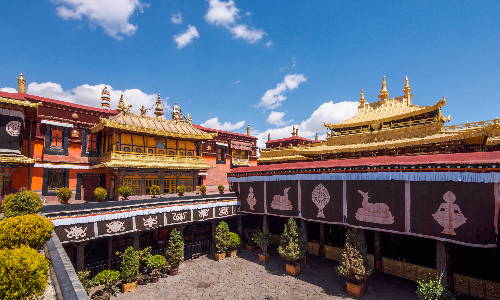
This morning, your local guide will meet you at your hotel lobby, and we will visit two famous monasteries. The first one is the Drepung Monastery. Drepung Monastery, built in the Ming Dynasty, is one of the six major monasteries of the Gelugpa sect of Tibetan Buddhism. And it is the largest monastery in the world. At the beginning of the 20th century, the number of monks here was as many as 10,000 people. The most important Tibetan festival “Shoton Festival” is held here every year. People come together to Drepung Monastery to watch the annual event of Sunning the Buddha. The huge Buddha Thangka will be hung on the mountain for exhibition.
Then we will visit Sera Monastery. Sera Monastery may not be as grand and colorful as Drepung Monastery, but it is also one of the three major monasteries in Lhasa. Thousands of Vajra Buddha statues are preserved in Sera Monastery, mostly made in Tibet. There are also many bronze Buddha statues brought from the other provinces in China or India. The debating of Buddhist scriptures here is very distinctive. It usually starts at 15:00 and can be watched by visitors. The debating takes place in a garden, which is at the northern end of the passage to the main gate. There are two types of debating of Buddhist scriptures. One is for two people to participate. One person asks, the other answers. The answerer cannot ask back. The other is multi-participation. One person or multiple people can ask questions and one person answers. They discuss the truth in the Buddhist scriptures in this way. Besides the Sera Monastery, the celestial burial platform behind the Monastery is also a holy place. However, the road to the celestial burial platform is very bumpy, and the Tibetan government does not allow travelers to see the celestial burial to respect the local customs. The rest of the day is free, and you would explore the city on your own.
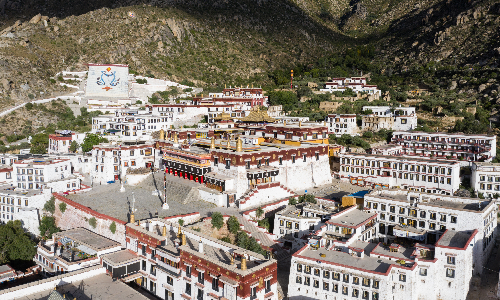
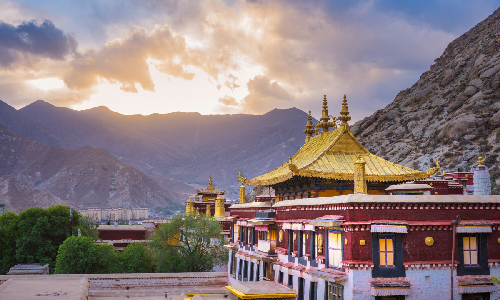
 Chengdu
Chengdu Today you will take the estimated flight CA4402 10:55/12:50 to Chengdu. Your tour guide will be holding your name sign and waiting for you at the airport. Then you will be transferred to your hotel and check in. The rest of the day is free on your own.
After breakfast, our guide will meet you at your hotel lobby and then your wonderful Chengdu tour will start!
We will first visit the Chengdu Research Base of Giant Panda Breeding. The base completely simulates the living environment of giant pandas in the wild. There are lakes, streams, bamboo forests, lawns, etc. There are more than 150 pandas here. You can also see other animals such as black-necked cranes and peacocks. And you could see the most adorable newborn baby pandas at the Sun and Moon Birthing Rooms. We always go to visit the panda base in the early morning because the pandas will be eating, drinking, and playing then. You could take many pictures for them. And the panda will fell asleep soon after satiation. If you want to see how the panda food was made, we can visit the panda kitchen from 8:00 to 9:00 in the morning.
Then we will visit the Jinsha Site Museum (closed each Monday). The Jinsha Site Museum is a site from the Shang and Zhou dynasties(1600BC-256BC), with a mass of ivory vessels and the largest quantity of gold and jade artifacts in the world from the same period. The most famous relic is the gold foil ornamentation named the “Sun and Immortal Birds Gold Ornament” in the fourth exhibition hall. It is the symbol of Chinese cultural heritage and vividly shows the worship of birds and the sun in ancient times.
Our last stop is Wide and Narrow Alley. It is composed of Wide Alley, Narrow Alley and Well Alley and is one of the surviving ancient neighborhoods of the Qing Dynasty in Chengdu. In the Wide Alley, you can see many well-preserved old buildings. You can also taste tea, eat Sichuan cuisine, and experience the customs of the old Chengdu here. Narrow Alley is a leisure area with western food culture and western art. Well Alley is a folklore experience area where you can immerse yourself in the daily life of old Chengdu. At the end of the city tour, you will be transferred back to your hotel.
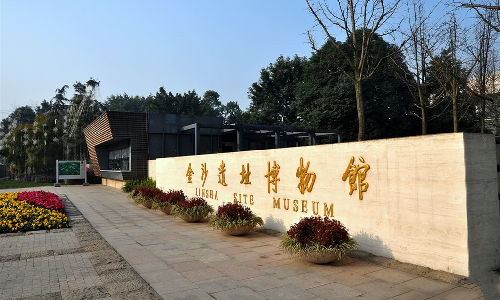
This morning we will drive for about 130 minutes (150KM) to visit the Leshan Giant Buddha. It is to the south of Chengdu. The Giant Buddha is a fine art of sculptures on precipices in the Tang Dynasty. It is a seated Maitreya statue. And it took 90 years to complete the 71-meter-high Buddha. It is the largest stone cliff statue in China. The Leshan Giant Buddha is located next to the Lingyun Temple. And there are many people who go to the Lingyun Temple to burn incense and worship the gods. Therefore, this area has become a holy place for Buddhism. In addition to going up the mountain to see the Buddha closely, you can also take a boat ride to see the Buddha from a distance and get a full view.
In the afternoon, we will drive for about 2 hours (110KM) to Huanglongxi Town which is to the north of the Leshan Giant Buddha. It is an ancient town with a history of more than 1700 years. The town is also known as “Chinese Hollywood”. The ancient town not only owns gorgeous views, but also is a natural film and television shoot base. There are many restaurants in the town. The most recommended delicacies are caramelized pork elbow and sesame cakes. Then we will transfer you back to Chengdu downtown, and you can explore Chengdu on your own and enjoy the leisure evening.
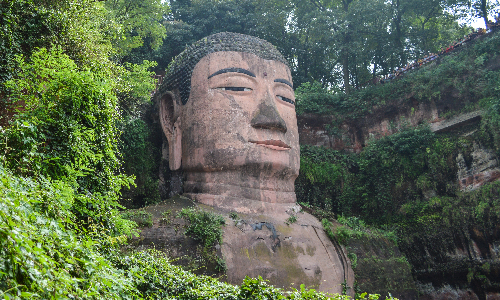
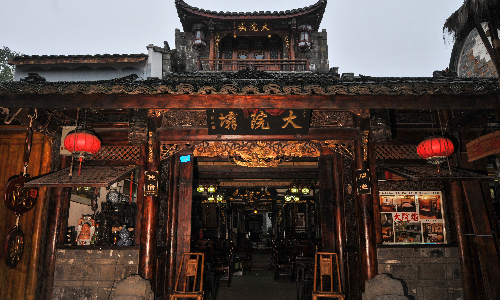
 Shanghai
Shanghai This morning, you will take the estimated flight MU5404 10:00/12:40 to Shanghai. The guide will meet and welcome you at the arrival hall of the airport. After check-in at your hotel, the tour guide will take you to the most famous street in Shanghai- Nanjing Road. Nanjing Road is one of the ten most famous pedestrian streets in China, where includes department stores, local snack stalls and time-honored brand shops, making it a shopping paradise. You can have some free shopping time there.
Then you will see the Bund. The Bund is one of the most symbolic sights of Shanghai. There are dozens of exotic buildings in different styles running from south to north on the Bund. From the Bund, you can see skyscrapers such as Jinmao Tower and Shanghai Tower standing on the other side of the river. At night, the neon lights on both sides of the river make it a perfect place to stroll around with your lover or friends and feel the charm and romance of the “magical city”.
Night Option: You could take a Huangpu River Night Cruise to have in-depth sightseeing of Huangpu River. Aboard the cruise, you can enjoy the spectacular night view of Shanghai along the way, feel the cool breeze, and have a relaxing time. This would be a great experience for your Shanghai tour.
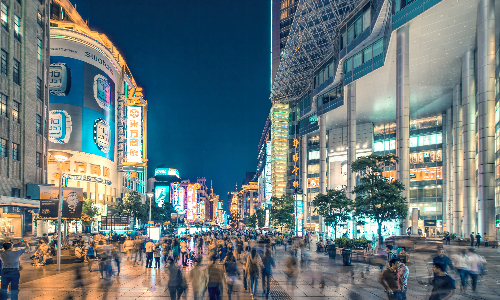
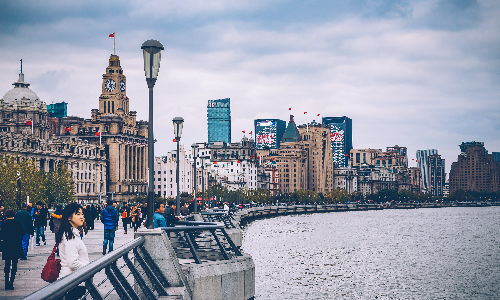
Today you will first visit Yu Garden (closed each Monday) which was originally a private garden in the Ming Dynasty, with a history of more than 450 years. It was built by an official, named Pan Yundun, for his father to spend the leisure time after retirement. The present Yu Garden covers an area of 20,000 square meters. Then you will have some free time to do shopping in the nearby bazaar area outside the garden.
After lunch, we will see the Shanghai Tower which is the tallest building in China. It is 632 meters high with 127floors above ground. You will take the world’s fastest elevator up to the observation deck at 546 meters. It is like walking in the clouds during the visit, with a panoramic view of both sides of the Huangpu River.
Then we will go to Tianzifang Market. As you walk through the alleys in Tianzifang Market, small specialty shops and art studios pop into view. Teahouses, alfresco restaurants, Cafes, galleries, home furnishings, handicrafts, as well as many of Shanghai’s most famous creative studios, there is always one of them that interests you. You can choose to have dinner here on your own or be transferred back to the hotel with your guide.
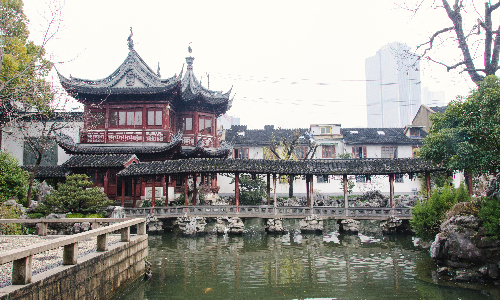
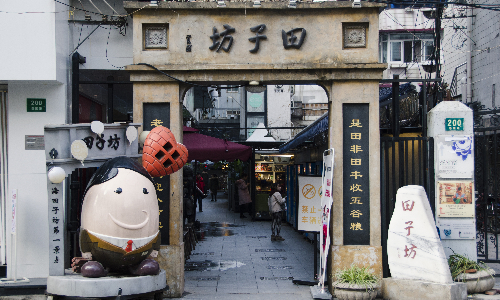
Today is the last day of your trip to China. Your guide will take you to the airport according to the time of your flight and help you to check-in. Have a nice and safe trip!
Editor: Summer Hou
Proofreader: Betsy He
| City | Five Star hotel list | Four Star hotel list |
|---|---|---|
| Beijing | Sunworld Dynasty Hotel Beijing Wangfujing | Sunworld Hotel Wangfujing |
| Xi'an | Tianyu Gloria Grand Hotel Xi'an | Sunworld Dynasty Hotel |
| Lhasa | Shangri-La Hotel, Lhasa | Thangka hotel |
| Chengdu | Sofitel Chengdu Taihe | Holiday Inn Express Chengdu Jinniu |
| Shanghai | Ocean Hotel Shanghai | Courtyard by Marriott Shanghai Central |
 |
![]() About your child or infant, please contact us for a discounted price.
About your child or infant, please contact us for a discounted price.



We started with a few days in Beijing & ended in Shanghai, from where we visited the Forbidden City and Great Wall. In between we visited Terra Cotta Warriors Museum, Panda Base, Shanghai Disneyland.

We had a wonderful holiday in China which will remain long in the memory. China is a breathtakingly beautiful country full of splendid temples and palaces, mountains and rivers, peaceful rural scenes and bustling shopping streets.
 QUICK ENQUIRY
QUICK ENQUIRY